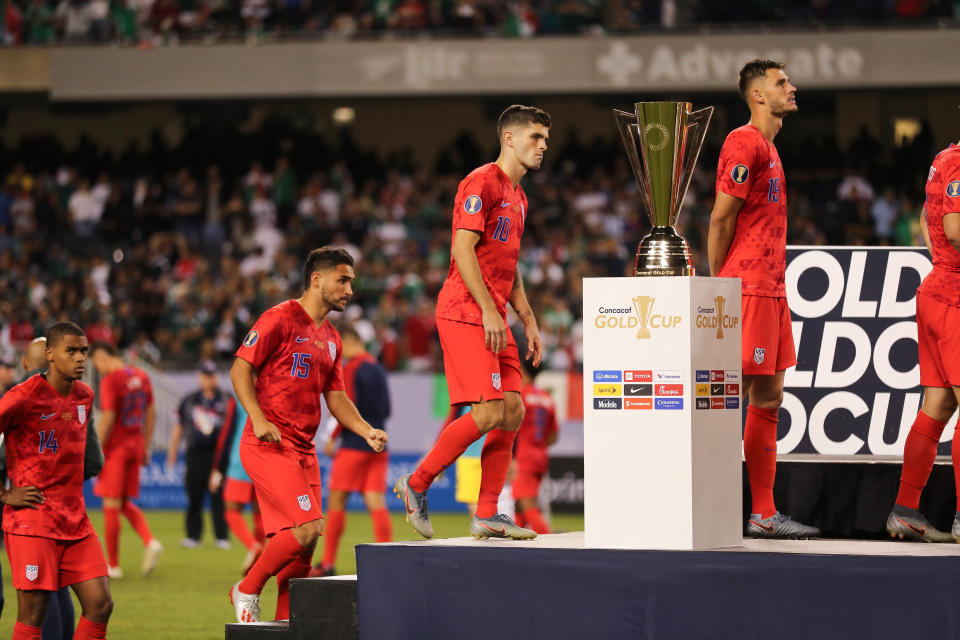Looking back at the USMNT's up-and-down 2019
If the story of 2019 for the United States men’s national team were a movie, it would be broken down in three acts. The first was full of optimism, with a permanent coach, Gregg Berhalter, hired after more than a year without one. The tension in the plot emerged during the middle segment, when the first signs of trouble began to show. That drama only intensified during the final act, as the tale reached its climax and ultimately a relatively happy ending.
“When I look back at 2019, I think the group has really come together nicely,” Berhalter said after the USMNT beat Cuba 4-0 on Tuesday to advance to June’s CONCACAF Nations League semifinal against Honduras. “We had a number of challenges in this year that the group needed to respond to. And I think we responded well. When I look at our overall goals of the year, it was to win the Gold Cup and to qualify for the semifinals in the Nations League. And we came up short in the first one, but we achieved the second one, and overall I think it was a really good year of development for this group.”
Still, the reviews for Berhalter’s first year at the helm remain decidedly mixed. Let’s break down how it unfolded, with what promises to be a pivotal 2020 for the Americans approaching fast.

Gregg Berhalter’s USMNT Honeymoon
While Dave Sarachan served with dignity as the program’s interim boss after the 2018 World Cup qualifying disaster, Berhalter’s arrival signaled a fresh start. He was an up-and-coming bench boss who had represented the U.S. on the biggest stage. Say what you want about the process that led to his hiring — then-U.S. general manager Earnie Stewart interviewed just one other coach, then-FC Dallas boss Oscar Pareja — but Berhalter was a strong candidate. He played and coached in both Europe and MLS, a unique qualification. He had clear ideas about how to win and his players swore by him with the Crew, which he led with distinction despite a shoestring budget and uncertainty surrounding the team’s future in Columbus.
His tenure at the top level couldn’t have gotten off to a better start. A win over a full-strength Ecuador in March followed victories against Panama and Costa Rica in January and February. A tie against South American champ Chile was more than respectable, even if it foreshadowed the U.S. struggles keeping the ball against high-pressing foes.
The Gold Cup
Adversity arrived in a hurry when the U.S. dropped its final two tuneups before CONCACAF’s biennial regional championship. The losses against Venezuela and especially Jamaica may have come with a host of key regulars missing, but the performances were shockingly poor nonetheless.
They were also quickly forgotten when the tournament kicked off. The Americans acquitted themselves well through the group stage, and the 6-0 triumph over Trinidad and Tobago, the team that shockingly eliminated the U.S. from Russia 2018, was particularly satisfying for supporters. Professional wins over Curacao and Jamaica in the quarterfinals and semis were less convincing, but the home team still went into July’s final against blood enemy Mexico having conceded just a single goal.
The defense held firm again in the decider. But after a promising start, the gulf in class between El Tri and the Americans became apparent over 90 minutes in Chicago, with Mexico ultimately prevailing on Jonathan dos Santos’ late strike.
Fall struggles and the USMNT response
Things took a dark turn in the rematch two months later. Mexico beat the wheels off the U.S. in an early September friendly in New Jersey, a 3-0 drubbing in which the home team looked tentative and committed error after error. Worse than the hideous scoreline was Berhalter’s defiant take afterward that it was actually an improvement on the Gold Cup showing. For the first time, questions about the coach’s ability to lead the U.S. back to the World Cup were being asked. The subsequent draw against a quality Uruguay side did little to quell the concern.
There was no way for Berhalter to positively spin a 2-0 upset in Canada in October, the USMNT’s first loss to Les Rouges in a competitive match in almost four decades. Worse still was the fact that the visitors conceded both goals after Berhalter had substituted his best player, Christian Pulisic, from the contest. Suddenly, the U.S. was in real danger of not advancing from a CONCACAF Nations League group containing the Canadians and Cuba. Suddenly, a coaching change felt possible, even after Stewart publicly backed his pick.

But facing must-win matches against both countries this month, the U.S took care of business, despite the absence of Pulisic and several other injured starters.
“We knew after the Canada loss last month that we had to win both these games,” said Jordan Morris, probably the team’s most consistent player in 2019. “To do that is a great feeling.”
The 4-1 victory over Canada last week made a statement. It wasn’t pretty, but it did show two things that had been sorely lacking in September and October.
The American players displayed the fight and commitment that used to be the program’s hallmark but had been lacking dating back to the end of the Jurgen Klinsmann era in 2016. Berhalter also showed a pragmatism in his approach that had been missing earlier by opting for a more direct style, at least in these two games.
That flexibility will be important moving forward. He also pulled the right strings from a lineup perspective, betting on Gyasi Zardes and Jackson Yueill to have big games against Canada (they did) and that his squad wouldn’t need European-based regulars John Brooks and Sergino Dest against Cuba (they didn’t), a decision made with longer-term benefits in mind.
“As we move forward to 2020, it’s an exciting year,” Berhalter said. “We move into Nations League semifinals and hopefully finals, and then we start World Cup qualifying. So this group is really going to get tested in 2020, and we're looking forward to the challenge.”
Wednesday, Nov. 20

